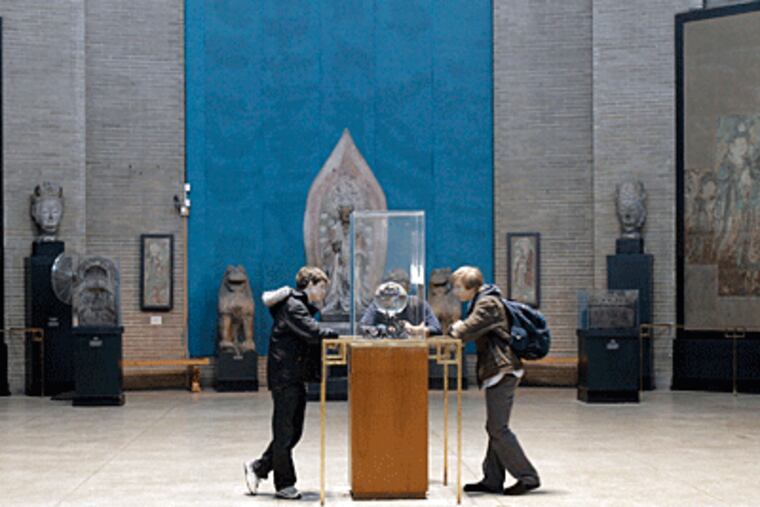U. of Penn museum plans to go popular
It will lay off 18 researchers, but refurbish exhibits to attract paying visitors.

Faced with a worsening deficit, the venerable, research-driven University of Pennsylvania Museum of Archaelogy and Anthropology is seeking to reinvent itself as an updated "tourist magnet."
As an initial step, the director has laid off 18 researchers, though some may stay if grant money can be found to cover their salaries.
"We were living beyond our means," said Director Richard Hodges. He said the museum's finances are unsustainable, and that the museum must refurbish its exhibits and "get its income up."
News of the potential layoffs dismayed scholars inside the museum and out. The 120-year-old Penn museum has a worldwide reputation for its scholarship and for supporting expeditions - from the tombs of Egypt to the temples of the Mayans to the remains of Babylon, Gordion and Troy.
Several prominent scientists could soon lose their jobs, including Patrick McGovern, a chemical archaeologist who has made national headlines with his analyses of stains on ancient vessels, some revealing the world's oldest wines and beers.
These researchers are "the last thing you'd give up" if the new mission still rests on "obtaining and disseminating knowledge," said Irene Winter, a fine arts professor at Harvard.
"I agree it's a bit of a shock to get rid of some," said Hodges, a British archaeologist who took over as the Penn museum's director in 2007. "But we've made it clear to many of them if we can find the funding, we'll keep them."
Hodges said he created the new "Five-Year Museum Strategy" last spring, which aims to draw more visitors by "refurbishing the tired exhibits."
A six-page summary says the museum must also strengthen links with its far-flung research locations from Thailand to Guatemala and make its "million-plus artifacts" more open to the Web.
The plan floats the possibility of adding a high-end restaurant in the museum.
The researchers were told of the potential layoffs individually in late November.
At the same time, the museum canceled a 50-year-old program called the Museum Applied Science Center, which incorporated molecular analysis, biology and other disciplines to study artifacts and sites.
The museum, which is part of Penn, has long relied on the university to shore up its finances. The museum received $7 million from Penn to balance its $16.4 million budget in 2008, according to the annual report.
Chief operating officer Melissa Smith said she could not disclose the size of the museum's endowment or its deficits. She said the museum has had to dig into reserves, which are eroding fast.
The museum will still support some archaeological digs and other research, done by its 12 curators and numerous students who work with them, Hodges said. The museum also draws on around 100 "research affiliates" who volunteer varying amounts of time, though many hold full-time jobs elsewhere.
Associate director and Mediterranean section curator C. Brian Rose says the economic crisis made it necessary to lay off researchers.
As president of the Archaeological Institute of America, he said, he has witnessed endowments drying up across the board. "It's happening at virtually every learned society and educational institution," he said.
Rose said he saw no options. "We're cut to the bone in publications, in exhibits, in security," he said. "If we were to lay off people in any of those areas, we couldn't keep the museum open."
As a curator, he said he's hoping to scrape together enough money in the next month to save the two researchers in his section.
Scholars outside the museum have been trying to make sense of Hodges' decision to cut so much research.
"He's firing the very people who are making the university museum an important academic institution," said Oscar Muscarella, a Penn museum-trained archaeologist and retired curator from the Metropolitan Museum in New York.
He fears the museum's new strategic plan threatens its long-standing leadership position. "What he's doing is reducing the value of the museum as a major archaeological and cultural institution."
Harvard's Winter said she was particularly concerned by the disbanding of the Museum Applied Science Center for Archaeology. "It was founded to emphasize not just the accumulation of artifacts but also the scientific analysis" used to understand ancient cultures, she said.
Among the endangered researchers with the center are Naomi Miller and Kathleen Ryan, who gleaned clues to humanity's past from traces of ancient plant matter, bones and animal skins.
Miller has used plant remains to determine how much ancient cultures depended on herding sheep and goats and how much they depended on farming grains. That tells her which types of agricultural systems were not sustainable in the long-run.
"This could have implications for today," she said.